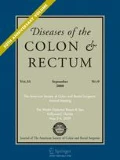Abstract
PURPOSE: Unlike classic Hirschsprung's disease, short-segment and ultrashort-segment varieties are usually found to be latent and milder. Ultrashort-segment Hirschsprung's disease may present as intractable chronic constipation in children over one year of age, adolescents, and adults. Anorectal myectomy has been shown in many instances to provide effective long-term treatment for certain patients with ultrashort-segment Hirschsprung's disease. Histologically, the affected segment in Hirschsprung's disease has been shown to have increased cholinergic nerves, lack of nitric oxide synthase-containing neuronal elements, and show moderate to severe loss of myenteric neurons. METHODS: Here, we report three cases that showed clinical and manometric evidence of ultrashort-segment Hirschsprung's disease. Two of the three patients responded well to myectomy. RESULTS: Detailed histologic and immunohistochemical evaluation of the internal anal sphincter and a comparison with three normal controls revealed absence of nitric oxide synthase-containing neurons in both cases that responded well to surgery and continued presence of these neurons in the patient who did not respond. A review of the current literature on various treatment modalities is included. CONCLUSIONS: Anorectal myectomy provides long-term relief of this chronic problem in a subgroup of patients with ultrashort-segment Hirschsprung's disease who lack nitrinergic neurons at the internal anal sphincter.
Similar content being viewed by others
References
Hirschsprung H. Stuhltragheit neugeborener in folge von dilatation und hypertrophie des colons. Jahrbuch Kinderheilkunde 1888;27:1–7.
Swenson O, Raffensperger J. Hirschsprung's disease. In: Raffensperger JG, ed. Swenson's Pediatric Surgery. East Norwalk: Appleton and Lange, 1990:555–77.
Cuffari C, Rubin SZ, Krantis A. Routine use of the nitric oxide stain in the differential diagnosis of Hirschsprung's disease. J Pediatr Surg 1993;28:1202–4.
Vanderwinden JM, De Laet MH, Schiffmann SN,et al. Nitric oxide synthase distribution in the enteric nervous system of Hirschsprung's disease. Gastroenterology 1993;105:969–73.
Wheatley MJ, Wesley JR, Coran AG, Polley TZ Jr. Hirschsprung's disease in adolescents and adults. Dis Colon Rectum. 1990;33:622–9.
Lynn HB. Rectal myectomy for aganglionosis megacolon. Mayo Clin Proc 1966;41:289–95.
Backwinkel KD, Oakley DW, Tuffli GA. Rectal myectomy for short segment aganglionic megacolon. Surg Gynecol Obstet 1971;132:109–13.
Singaram C, Sengupta A, Sweet MA, Sugarbaker DJ, Goyal RK. Nitrinergic and peptidergic innervation of human esophagus. Gut 1994;35:1690–6.
Singaram C, Sweet MA, Gaumnitz EA, Cameron AJ, Camilleri M. Peptidergic and nitrinergic in congenital esophageal stenosis. Gastroenterology 1995;109:275–81.
Singaram C, Sengupta A, Spechler SJ, Goyal RK. Mucosal peptidergic innervation of the opossum esophagus and anal canal. J Auton Nerv Syst 1990;29:231–40.
Gaumnitz EA, Sweet MA, Sengupta A, Singaram C. The nitrinergic system in human colon and its relationship with the peptidergic enteric nervous system. Neuropeptides 1995;29:1–9.
Nissan S, Bar-Maor JA. Further experience in the diagnosis and surgical treatment of short segment Hirschsprung's disease. J Pediatr Surg 1971;6:738–41.
Lawson J. Hirschsprung's disease. In: Keighley M, Williams N, eds. Surgery of the anus, rectum and colon. London: WB Saunders, 1993:2351–414.
Joseph VT, Sim CK. Experience in the surgical management of Hirschsprung's disease. Ann Acad Med Singapore 1987;16:518–26.
Ortiz VN, Cebollero J. Rectal myectomy in the management of short segment Hirschsprung's disease. Bol Assoc Med P R 1988;80:460–2.
Momoh JT. Short segment Hirschsprung's disease: a ten-year review from Zaria, Nigeria. Trop Doct 1988;18:16–9.
Lynn HB, van Heerden JA. Rectal myectomy in Hirschsprung's disease: a decade of experience. Arch Surg 1975;110:991–4.
Fishbein RH, Handelsman JC, Schuster MM. Surgical treatment of Hirschsprung's disease in adults. Surg Gynecol Obstet 1986;163:458–64.
Yoshioka K, Keighley MR. Anorectal myectomy for outlet obstruction. Br J Surg 1987;74:373–6.
Hamdy MH, Scobie WG. Anorectal myectomy in adult Hirschsprung's disease: a report of six cases. Br J Surg 1984;71:611–3.
Author information
Authors and Affiliations
Additional information
Supported in part by the Department of Veterans Affairs, VA MERIT Award, American Federation for Aging Research, University of Wisconsin Graduate School, and US-Israel Binational Science Foundation, Madison VA GRECC Publication 96-08.
About this article
Cite this article
Moore, B.G., Singaram, C., Eckhoff, D.E. et al. Immunohistochemical evaluations of ultrashort-segment Hirschsprung's disease. Dis Colon Rectum 39, 817–822 (1996). https://doi.org/10.1007/BF02054450
Issue Date:
DOI: https://doi.org/10.1007/BF02054450




